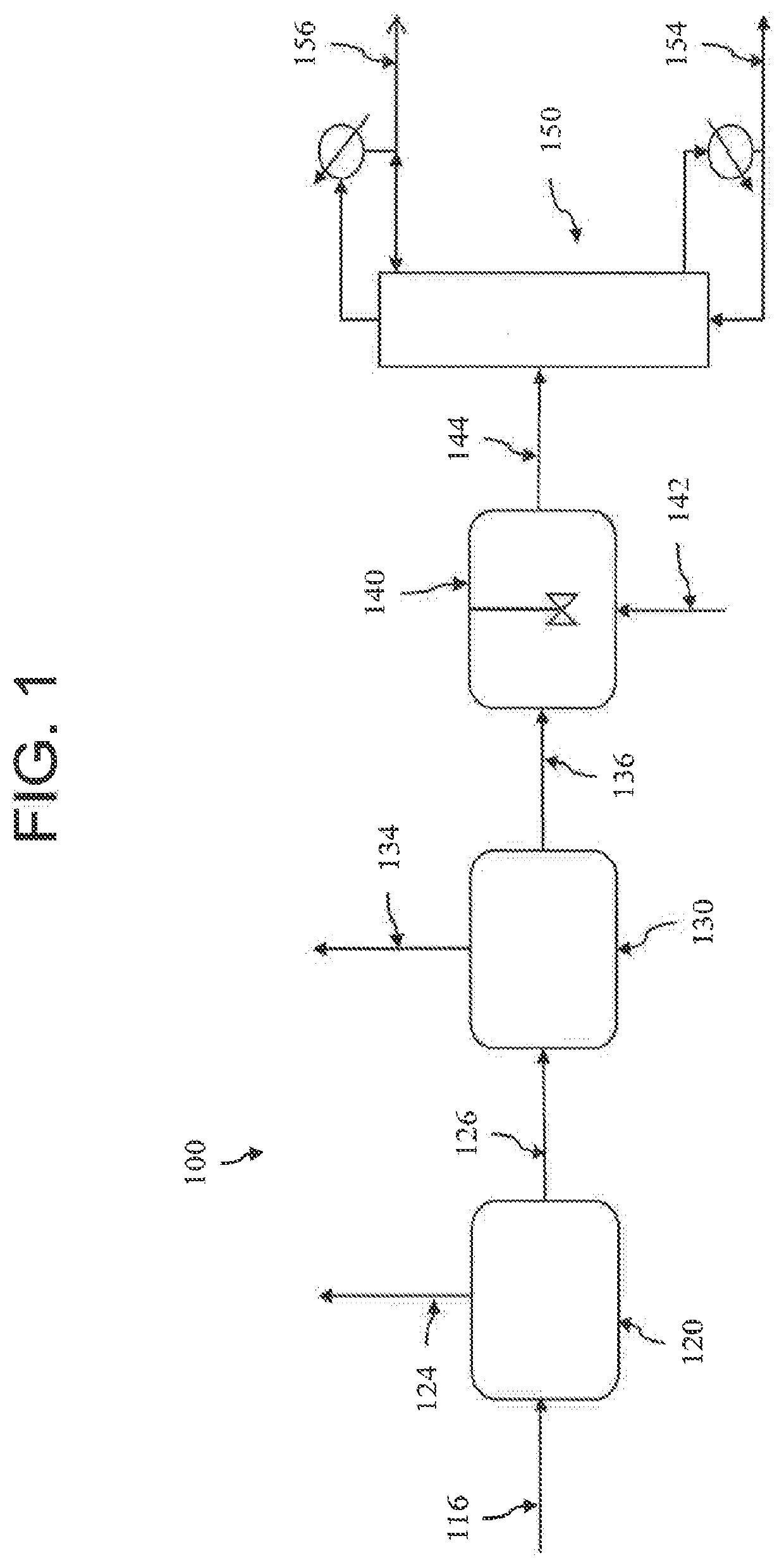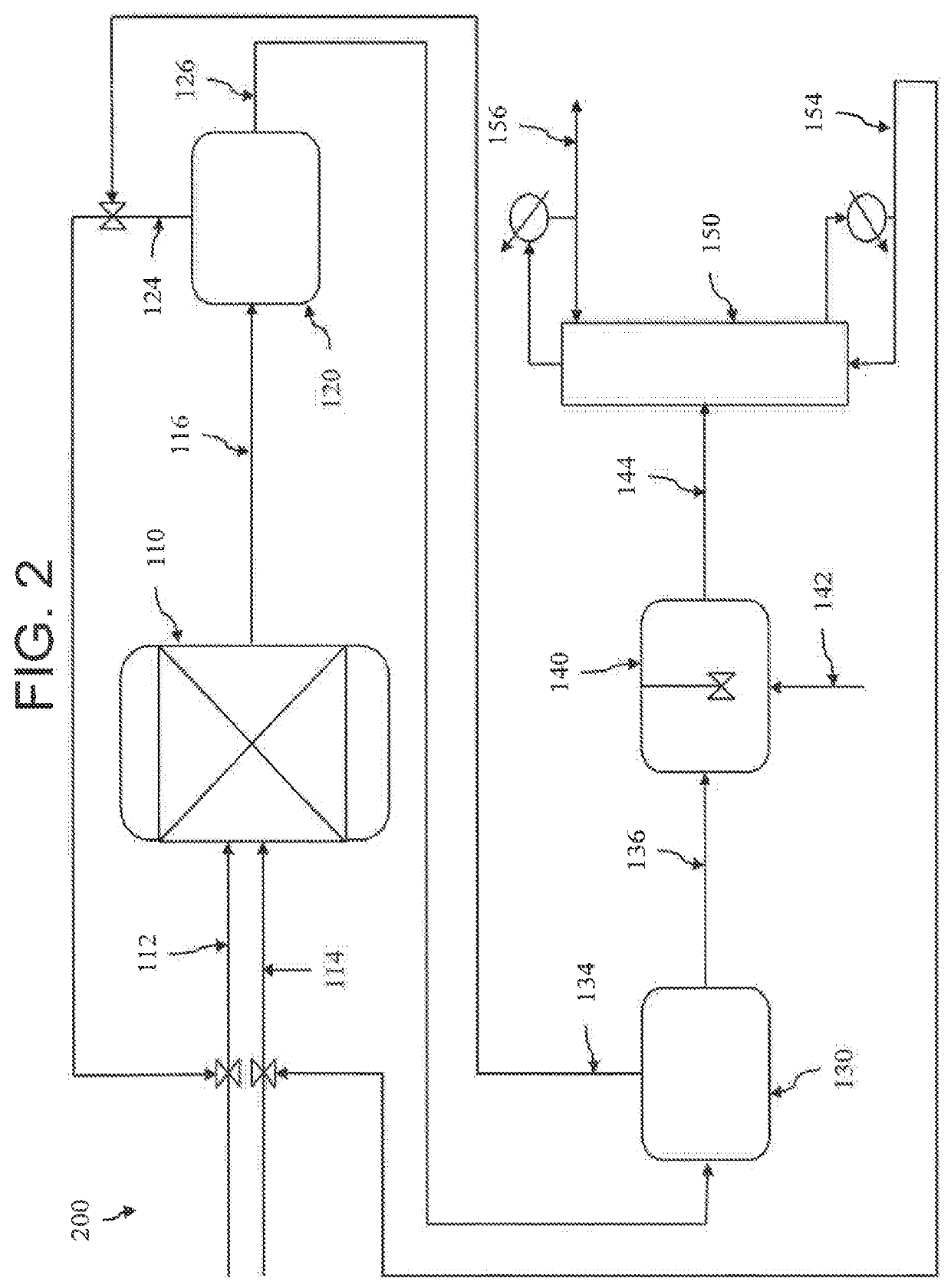Processes and systems for recovering methanesulfonic acid in purified form
- Summary
- Abstract
- Description
- Claims
- Application Information
AI Technical Summary
Benefits of technology
Problems solved by technology
Method used
Image
Examples
Example
Example 1
[0058]A reaction stream of 4,950 pph sulfur trioxide (“SO3”) is mixed with 11,550 pph sulfuric acid (“H2SO4”) and enters a reactor, where 2,310 pph methane (“CH4”) is added at a pressure of 40 bara. A reaction initiator of, e.g., a 50% hydrogen peroxide solution, flows at about 75 pph into the reactor. The mixture flows through the reactor, or systems of reactors, obtaining a 95% conversion of SO3 to methanesulfonic acid (“MSA”). Obtaining greater than 95% conversion can be done, with the costs being extremely high to achieve >99.9% conversion. Even with 99.9% SO3 conversion there will remain over 300 ppm SO3 in the reaction product.
[0059]The reactor outlet stream is sent to an isentropic flash at 100 psi. Most of the methane is removed and either recovered or burned for fuel value. Only about 10% of the remaining SO3 goes overhead with the methane. The resulting stream contains about 5455 pph MSA, 11,750 pph sulfuric acid, 37 pph methane and about 210 pph SO3.
[0060]The hea...
Example
Example 2
[0063]This Example shows a system employing a very high conversion of SO3 in the reactor section. The feed is the same as discussed in Example 1. The only major change is a polishing reactor is employed after a first set of reactors to achieve a SO3 conversion of 99%.
[0064]The outlet stream of the reactor section contains about 5684 pph MSA, 11,754 pph H2SO4, 1361 pph methane and 48 pph SO3.
[0065]After a first flash there is still 42 pph SO3 in the MSA / H2SO4. If the MSA was separated from the H2SO4, a large portion of the SO3 would remain in the MSA stream. The concentration of SO3 remaining in the MSA stream would be about 7333 ppm.
[0066]However, in this Example, water is added to convert the SO3 to H2SO4. The stream is then vacuum flashed and sent to the same distillation column. The resulting MSA contains no SO3 and 33 ppm H2SO4.
Example
Comparative Example 1
[0067]This Comparative Example demonstrates the benefits of the invention by illustrating the problems arising from separation processes outside the scope of the invention.
[0068]The feeds of this Comparative Example are the same as the feeds used in Example 2. The only difference is that no water is added to convert the SO3 to H2SO4. In this case, the MSA has an SO3 impurity level of about 40 ppm, in addition to about 33 ppm H2SO4. When the anhydrous MSA is mixed with water, the SO3 will be converted to H2SO4 and the MSA will have over 80 ppm H2SO4 in it. This amount of sulfuric acid renders the MSA undesirable for many industrial applications.
[0069]Within this specification, embodiments have been described in a way which enables a clear and concise specification to be written, but it is intended and will be appreciated that embodiments may be variously combined or separated without departing from the invention. For example, it will be appreciated that all prefe...
PUM
| Property | Measurement | Unit |
|---|---|---|
| Fraction | aaaaa | aaaaa |
| Fraction | aaaaa | aaaaa |
| Fraction | aaaaa | aaaaa |
Abstract
Description
Claims
Application Information
 Login to view more
Login to view more - R&D Engineer
- R&D Manager
- IP Professional
- Industry Leading Data Capabilities
- Powerful AI technology
- Patent DNA Extraction
Browse by: Latest US Patents, China's latest patents, Technical Efficacy Thesaurus, Application Domain, Technology Topic.
© 2024 PatSnap. All rights reserved.Legal|Privacy policy|Modern Slavery Act Transparency Statement|Sitemap


